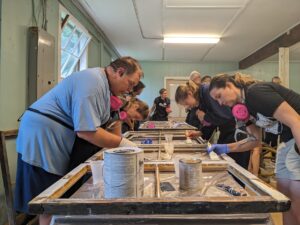
The New, The Old, and the Hype
- May 17, 2008
- 7:56 pm
- May 17, 2008
- 7:56 pm

A special advertising section in today’s Democrat & Chronicle made me see red this morning.
It’s one of those advertisements that is written and laid out to resemble an actual newspaper article, but is really a paid advertisement, in this case paid for by the Rochester Home Builders’ Association (as the fine print on the top of the page reveals). The text of the ad claims that thanks to the many new energy-saving products out there, new houses are superior to old ones.
Of course, given the source, all the people quoted are affiliated with the home-building industry, so it’s their job to sell new houses, replacement windows and vinyl siding. In a couple of spots, the author of the ad throws in a reference to retrofitting existing houses, but – surprise! – nearly all the text is devoted to convincing us that, as the 2008 president of the Rochester Home Buyers Association is quoted as saying, “In everything from HVAC systems, lighting and appliances to the entire outside, a new home is better than an older home.”
Well, I for one don’t buy the one-sided hype of faux articles like this. Of course these people who sell new houses and all the products associated with them want to convince us how great their products are. But nowhere does the ad mention the environmental costs of all those new houses. Nearly all of them are built on former farmland or other undeveloped open space – where’s the environmental benefit of that? All those materials had to be manufactured, many of them, like vinyl, in environmentally damaging ways – where’s the environmental benefit of that? All those materials had to be transported to the site – where’s the environmental benefit of that? Chances are the new house is on the fringes of our area, in a neighborhood with no sidewalks or anything to walk to, far from work and everywhere else its owners might go – where’s the environmental benefit of all that additional driving?
A new house may be more efficient to operate than an existing one –although given the many environmentally friendly features of older houses, like operable double-hung windows and shutters, sensitive site placement, mature trees, porches, and more, even that is not a given. But it is the epitome of wastefulness to build something new if it means throwing out the old, and in our region that is not experiencing population growth, doesn’t every new house equate to an abandoned house elsewhere?
What especially bothers me about this ad is how easy it is for those who want to sell new houses to get their message out, and how much harder it is for those of us who understand the benefits of conserving and reusing existing buildings to get our message out. The home builders and vinyl salespeople profit when someone buys a new house or wraps their house in plastic. Who makes money when a conscientious homeowner repairs her existing windows, ensuring that the irreplaceable old-growth wood survives into the next generation rather than being sent to the landfill?
This has been a hot topic in preservation circles, and there are more and more resources aimed at addressing this disparity of information and getting the tools out there to help us make our case. For example, an online “Embodied Energy Calculator” enables us to come up with an estimate of the embodied energy of an existing building (the energy that went into the construction of that building, and that would be thrown away if the building is demolished), the energy involved to demolish it, and the energy it would take to build a new building to replace the one that was lost. This information is not found in those articles and ads that only compare the energy it takes to operate a new building versus an old one. The National Trust for Historic Preservation’s Sustainability Initiative is providing national leadership on this very important issue, working to provide the resources and facts all of us in preservation need to get our message out and counter the misleading claims of the salespeople. We’ve been working on spreading the message locally, through our newsletter and website, an article in the Democrat & Chronicle’s Speaking Out column last May, and more.
We’re going to be thinking a lot about this issue in the months to come: how do we reach the people who haven’t yet gotten the message that (in the words of National Trust president Richard Moe) “we can’t build our way out of the global warming crisis” and “historic preservation has always been the greenest of the building arts.”
I’d love to hear what you think we can do to spread the word.
Posted by Katie Eggers Comeau, Advocacy Coordinator
SHARE





3 thoughts on “The New, The Old, and the Hype”
I think this is a great start on spreading the word, Katie. One thought I had was, shouldn’t the window restoration people want to run ads to get their point out? “Preserve the historic quality of your home while saving energy this winter” or something like that. Or even short of restoration, it seems like there must be easy cost savings from simple things like caulking, so someone could offer a nice “green home audit”-type business. Do you see much of this? Why do you think there isn’t more?
Hi Andy – I hope we will see more of this, but I fear we’ll be hearing even more about replacing windows and all the rest. For example, here in Rochester there are a few individual craftspeople who specialize in window repair, but dozens of window replacement contractors with lots of ads on TV and in the yellow pages, displays in the malls, etc.
Plus a lot of the maintenance work can be done by homeowners and there’s more money to be made selling replacement windows than selling caulk. (And what busy homeowner doesn’t love the promise of “maintenance free?”)
Unfortunately most of the energy audits I’ve heard of are being done by, guess who, the window replacement companies. I hope there are other options out there – I need to look into that!
Katie
Dear Katie – RG&e’s website indicates that they provide energy audits through a third party. They cost the average homeowner $100, but this fee is refunded with the first purchase of a recommended improvement. I used this service some years ago.
Comments are closed.